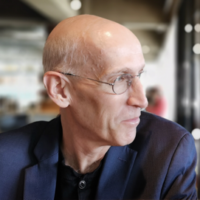Chinese New Year, also called the Spring Festival (春节), is a time each year when hundreds of millions of Chinese travel home to reunite with family and friends. Observers routinely note it is the largest human migration event on the planet.
This year, on the Sunday before returning to work from Spring Festival, an equally impressive number of Chinese downloaded an explosive on-line exposé on Chinese air pollution produced by former CCTV reporter Chai Jing. The film, called “Under the Dome,” is not the first Chinese effort to document the country’s growing environmental problems, but it is the first to generate this much interest.

In this screen capture from the film “Under the Dome,” Chinese reporter Chai Jing asks a child from a village in the heart of China’s coal country if she has ever seen the stars. “No” the child answers.
It may be the most frank and revealing piece of investigative reporting in the history of the People’s Republic. China’s new minister of environmental protection, Chen Jining, compared it to Rachel Carson’s “Silent Spring.” The virtual tsunami of Chinese commentary that flooded Chinese social media in the wake of the on-line release suggests Chen may be right, at least in terms of the possible impact on Chinese public policy.
Although the film was independently produced and released on-line, rather than on Chinese television, it appears to have the support of the Chinese government, even though it contains scathing criticism of powerful Chinese state interests. The Chinese Internet is aflame with speculation and concern. Some dissidents worry Chai could be silenced. Others are ridiculing her for collaborating with the government.
The impact in China
It is tempting, especially for U.S. observers, to identify the film’s astonishing appeal with its unusually frank criticism of the Chinese government. But another, more potent social force may be driving Chinese public interest in what Chai has done with the film.
The Chinese journalist opens by explaining how she felt when she discovered that the child she was about to bring into the world had a tumor. She suggested it might be related to her reporting on the air pollution in China’s coal country. That thought establishes a powerful personal bond to a Chinese audience just returning home from a national and cultural holiday that celebrates family.
Chai builds on that emotional connection by using the best science available to explain the causes and effects of China’s air pollution problem in a way that ordinary people can easily understand. She then notes, as many others have, that the Chinese government has passed laws to deal with it but nobody obeys them. This may be the most effective message in the film: everyone, not just the government, is responsible for that failure, which is as much a social and cultural shortcoming as a political one.
Finally, the film closes by issuing a wake-up call for action and urges people—in a positive and public-spirited voice—to be vigilant and personally accountable.
She notes that other cities, like London and Los Angeles, suffered the same problem as Beijing, yet managed to clean up while growing their economies at the same time. Chai left her audience believing that change was possible. The stock prices of Chinese environmental technologies companies soared the following day.
Time will tell whether Chai’s “Under the Dome” will have an impact comparable to Carson’s “Silent Spring.” If it does succeed in mobilizing a fifth of humanity to clean up the air, the entire planet will be able to breathe a sigh a relief.
